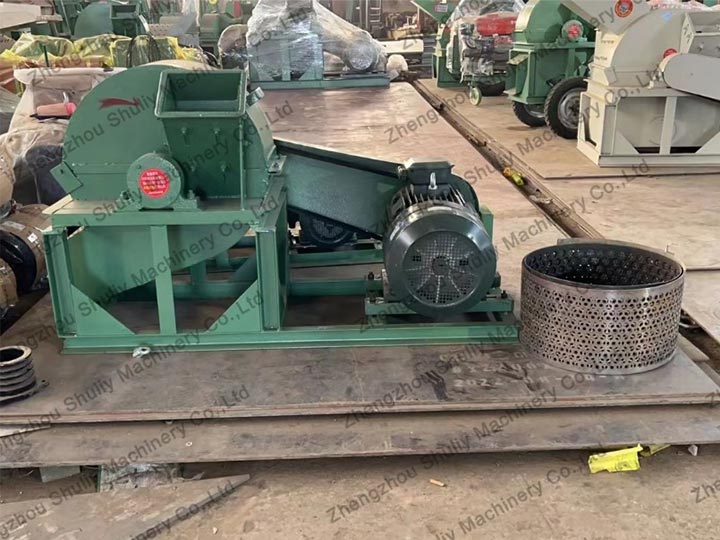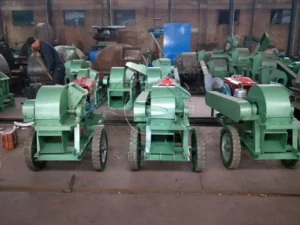工業用ハンマーミルは木材リサイクル工場や森林農場に不可欠なツールであり、木材廃棄物、枝、丸太、スクラップをチップやおがくずに効率的に粉砕します。これらの多用途機械には電気式とディーゼル式のモデルがあり、1 時間あたり 1 トンを超える処理能力を備えています。
自動コンベヤシステムを使用すると、生産量は 1 時間あたり 4 ~ 6 トンに達します。処理された生産物は製紙、菌類培養、木質ペレット生産などのさまざまな産業に利用され、これらのハンマーミルは大規模操業と持続可能な木材資源管理の両方に理想的です。
ハンマーミルクラッシャー加工用原料
ハンマーミルクラッシャーで処理すると、様々なバイオマス原料が利用可能になります。この産業機器は、木材スクラップを迅速に細かいフレークに変えることに長けており、木材のリサイクル作業に不可欠なツールとなっています。
ハンマーミル処理の一般的な原材料には:

- 木くず。 これらには、木材加工産業からの端材や端材が含まれる場合があります。
- 丸太と枝。 全体または部分的に処理されたログとブランチのサイズを効率的に縮小できます。
- ココナッツの殻。 さらなる用途のために簡単に細断できる丈夫な素材です。
- トウモロコシの穂軸。 これらはより小さな粒子に加工され、さまざまな産業用途に役立ちます。
- その他のバイオマス素材。 農業残渣および同様の有機廃棄物が含まれます。
ハンマークラッシャーの効率は、供給サイズが小さいほど大幅に向上し、生産量が増加し、生産効率が向上することに注意することが重要です。
適切な原材料を選択し、供給サイズを調整することで、オペレーターは木材リサイクルプロセスにおけるハンマーミルクラッシャーの利点を最大限に活用できます。

ハンマーウッドクラッシャーの最終製品

ハンマーウッドミルの主な生産物はおがくずです。顧客の要件に応じて、おがくずをさまざまな細かさで製造できます。
通常、おがくずの細かさは2mmから3cmの範囲です。この多用途性により、ユーザーは特定のアプリケーションのニーズに合わせて最終製品をカスタマイズできます。
ウッドハンマークラッシャーの主な利点
- 効率よく木材を粉砕します。 1 時間あたり 0.6 ~ 5 トンの効率で木材を粒子やおがくずに減らすことができ、木質ペレットやバイオマス エネルギーなどの用途に不可欠です。
- 多彩なマテリアルハンドリング。 丸太、枝、パレットなど様々な木材を加工できるよう設計されており、幅広い木材加工ニーズに対応します。
- 木材の無駄が減りました。 木材を効果的に均一な断片に分解することで、産業が資源を最大限に活用し、環境への影響を最小限に抑えることができ、最大 30% の廃棄物の削減に貢献します。
- 高い生産能力。 これらの機械は産業規模の作業向けに設計されており、大量の木材を処理でき、一部のモデルでは 1 時間あたり 4 ~ 6 トンの生産速度を達成します。
- 出力サイズを調整可能。 ユーザーが粒子サイズを制御できる調整可能なスクリーンを備えており、バイオマス燃料や動物の寝具などのさまざまな用途に適した、さまざまなサイズの木材チップやおがくずを生成できます。

工業用木材粉砕用ハンマーミルの構造
工業用ハンマーウッドミルの構造は、小型木材ミルと比較して効率と耐久性が向上するように設計されています。
主要なコンポーネントには次のものが含まれます。
- シェル。 すべてのコンポーネントを収納する堅牢な外装ケース。
- モーターまたはディーゼルエンジン。 破砕機構に動力を供給します。
- ファン (オプション)。 冷却と物質の排出を助けます。
- 滑車。 モーターを粉砕システムに接続します。
- ベアリング。 スムーズな操作を保証し、摩擦を軽減します。
- ハンマー(ブレード)。 主要な破砕要素は通常、耐久性のある素材で作られています。
- 内張りボード。 内面を摩耗から保護します。
- フレーム (オプション)。 さらなる安定性とサポートを提供します。
これらのコンポーネントが連携して高い処理効率と機械寿命の延長を保証するため、工業用ハンマーウッドミルは大規模な木材加工作業に最適です。


ハンマー木材破砕機の動力システム
ハンマーウッドシュレッダーの動力システムは通常、電気駆動またはディーゼルエンジン駆動を採用しています。
その中で、ハンマーウッドシュレッダーに搭載されているモーターはすべて純銅モーターであり、国際品質基準を満たしており、安全にご使用いただけます。
ディーゼル駆動の木材シュレッダーは現場作業に適しており、十分なパワーを備え、移動が便利で、故障率が非常に低いです。


ウッドハンマークラッシャーのスペアパーツ
木材破砕装置のスペアパーツには、主に破砕ハンマー、ライニングボード、スクリーンなどが含まれます。
インナーライナー
インナーライナーは機械の粉砕室の後壁の内側にあり、機械本体を摩耗から保護します。
主に厚さ18〜20mmの鋳鋼で作られており、丈夫で耐摩耗性があります。


粉砕ハンマー

ハンマーミルのハンマーの数は機械のモデルによって異なります。ハンマーの厚みは約8mmです。
従来のハンマーミルのハンマー数は72、大型ハンマークラッシャーのハンマー数は最大90です。
破砕ハンマーは木材破砕機の重要な部分です。高速運転中に木材チップをおがくずに砕くことができます。
ふるいスクリーン
木材シュレッダーのスクリーンは主にハンマーで粉砕されたおがくずをふるい分けるために使用されます。スクリーンの穴の直径よりも大きい木材チップを粉砕ビン内に保持して粉砕を続けることができます。
画面の厚さは約6mmです。スクリーン穴の直径は、さまざまな顧客のニーズに応じてカスタマイズできます。

ハンマーウッドクラッシャーはどのように機能しますか?
ハンマーウッドクラッシャーは、高速回転するハンマーによって生成される継続的な衝撃と摩擦の組み合わせによって動作します。
- モーターは回転するターンテーブルとハンマーを同時に駆動します。
- 木片や藁などの原材料が入口から供給されます。
- 高速のハンマーが材料を打ちつけ、衝撃でそれを粉砕します。
- 摩擦と繰り返しのハンマー打ちによって、材料はさらに細かい木くずに減少します。
- すべての粉砕は、機械のチャンバー内で単一の連続プロセスとして行われます。
この効率的なメカニズムにより、さまざまなバイオマス材料の迅速かつ効果的な処理が可能になり、ハンマーウッドクラッシャーは木材リサイクルとバイオマスエネルギー生産における貴重なツールとなっています。



おがくず処理プラントの完全な設計
高品質の木材チップを大規模に処理する場合、ハンマーミルだけでは単独で稼働できません。通常、多くの木材加工工場ではハンマーミルを使用する際に自動搬送装置や除塵装置を使用しています。
したがって、私たちの工場は、さまざまな顧客のニーズに応じてさまざまなおがくず処理プラントも設計しました。おがくず生産ラインの生産量は一般的に 500kg/h から 5t/h の間です。お客様の現場やご予算に応じて具体的な生産プランをカスタマイズいたします。




工業用ハンマー木材破砕機のお客様事例
この大型木材シュレッダーは、家具工場、森林農場、発電所などの大規模および中規模の木材加工工場に非常に適しています。
私たちはハンマーミルクラッシャーをマレーシア、オーストラリア、ニュージーランド、カナダ、チリ、ブラジル、米国、英国、ベネズエラ、ナイジェリア、南アフリカ、ソマリア、エジプト、サウジアラビアなどの外国に何度も輸出してきました。ロシア、キルギスなど

お問い合わせ
ハンマーウッドクラッシャーに加えて、木材削り機、ウッドチッパー機、ウッドデバーカー機など、幅広い木材加工ソリューションを提供しています。
私たちの各機械は、あなたの木材加工業務の効率と持続可能性に貢献するように設計されています。いつでもお気軽にお問い合わせください。私たちの専門チームが、より詳細な情報を提供し、あなたのニーズに合ったソリューションをカスタマイズします。







